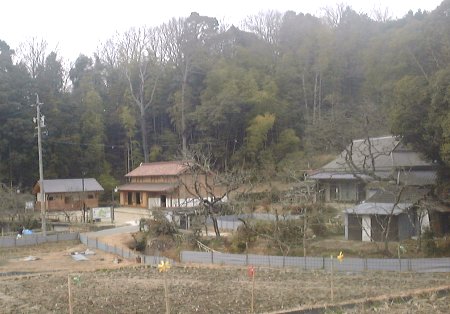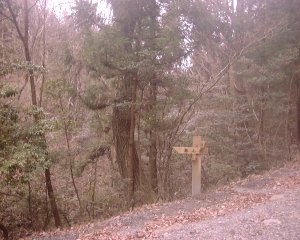| 海上の森 Kaisho-No-Mori (Photos taken on Jan. 21, 2007) |
| 2007年1月21日愛知県瀬戸市の「海上の森」へ行ってきました。 今回は「海上の森」の一部のみ散策しました。 次は「海上の森」の篠田砂防池、 多度神社、物見山などへ行こうと思います。 We went to "Kaisho-No-Mori" woods in Seto City, Aichi Prefecture Japan on January 21, 2007 to walk quietly in part of the woods. Next, we will walk in , "Shinoda Sabou Ike" sand control pond, Tado Jinja shrine and "Monomiyama" commanding height in "Kaisho-No-Mori" woods. 「海上の森」の駐車場に愛知県の説明板があります。説明板によると正式名称は 「愛知県海上の森自然環境保全地域」(平成18年3月24日指定)。 説明板左半分はここをクリック。 右半分の地図は下の写真参照。 There is an explanation board made by Aichi Prefecture at a parking lot of "Kaisho-No-Mori". The official name is " Aichi Prefecture Kaisho-No-Mori Nature Conservation Area" according to the board. (Designated on March 24, 2006) Click this for the left side of the explanation board. See a picture below for the right side. <愛知県の説明板の概要の一部> 海上の森は瀬戸市南東部に位置する都市近郊の里山で、全域に広がっている水系が 豊かな生態系をはぐくみ、西部一帯は花崗岩の上に砂礫層が堆積した地層で、地下水 の湧出による栄養分の少ない湿地が多く見られるとともに、尾根部にはアカマツ林、 山腹部にはコナラ林が分布している。 <Part of the Outline of the explanation board> "Kaisho-No-Mori" is a forest near satellite city situated in the southeast of Seto City. Water system which spreads throughout the whole area of the forest nurtures rich ecosystem. The layer of the whole west area is a gravel layer piled up on granite. Many innutritious wetland due to groundwater decrement are found in the whole west area. Red pine woods grow on the ridge of a low mountain and quercus serrata woods grows on the mountainside 駐車場から東へ約1kmで「海上の里」という休憩センターに到着。 "Kaisho-no-Sato" resting center is about 1 km east of the parking lot. 「海上の里」にはエコトイレシステムを利用したトイレがあります。 今年(2007年3月)に「海上の森」の駐車場にトイレが出来るまでは、 「海上の森」にはここしかトイレがありません。 There is a washroom using ecosystem in the center. This is the only washroom available in the "Kaisho-No-Mori" woods until another washroom will be set up in the parking lot in March, 2007. エコトイレシステムの説明板に次のように書いてあります 環境に優しい土壌を使った新しい浄化システム。 土壌のバクテリアにより汚水を高度に浄化。 きれいな処理水は、トイレの洗浄水に循環再利用。 消費電力がわずかで、省エネ設計。 シンプルなシステム設計で維持管理が容易。 利用者の変動にかかわらず、処理が安定。 Explanation board for washroom using ecosystem says: New purification system using environment friendly soil High purification of diry water by the use of bacterium in soil Circulation of clean treated water to reuse for washing washroom Small consumption of electricity energy and saving design Simple system design and easy maintenance Stable diry water disposal irrespective of the number of users 「海上の里」から北へ約500mで海上砂防池(通称、海上池又は瀬戸の大正池)へ到着。 農閑期のため、堰堤が開放されて、池には水がたまっていませんでした<写真参照>。 "Kaisho Sabou Ike" sand control pond (commonly called "Kaisho Ike" or "Seto Taisho Ike") is about 500m north of "Kaisho-no-Sato" resting center. Water was not stored in the pond since dam is opened due to the agricultural off season.<See picture below> 「海上の里」から海上砂防池への近道があるのを帰りに知りました。 ここを通ると 距離が200mは短縮される感じがします<写真参照>。 We found out a shortcut to "Seto Taisho Ike" from the "Kaisho-no-Sato" center on our way back to the center. About 200 m will be shortened when using the shortcut. <See picture below> 海上砂防池から「海上の里」へ戻ってきてちょっと行くと三叉路。ここに 「陶龍寺アトリエで喫茶」という紙が道案内標識の傍に張ってあった。ちょっと 気になり、ここで左(北)へ曲がり100m位の陶龍寺アトリエの前へ到着。 A junction of three paths is about 100m south of the "Kaisho-no-Sato" center. A paper, "tea drinking at Touryuji studio" is attached to a path guide sign at the junction where we went about 100m north to the studio. 陶龍寺アトリエ正面玄関からアプローチを歩いていくと入口手前に鳥居があり 「天照大神・・・」と説明があった。名前からお寺かなと思ったら、このアトリエが 陶龍寺であった。ちょっと意味がある感じのアトリエ兼喫茶室のようであったので 今回は入らなかった。 When entering at its front gate to the entrance, we found a torii (or a gateway at the entrance to a Shinto shrine) at the right hand side. There was a description of "Amaterasuoomikami (*)- - -" on the torii. Although I imagined the Touryuji was a temple from the name, it was a studio and tearoom. We did not enter into the studio because it seemed to be a little expressive. * "Amaterasuoomikami is deemed to be a god and ancestor of the Imperial Household of Japan. 陶龍寺の前の道路の脇に張り紙があり、本「海上の森奇譚」等の案内と一部手書き が次のようにありました。 <一部、ウェブ作者の推測による補足が入っています。> A bill beside the path in front of the studio shows notice of books such as "Kaisho-no-Mori Kitan" story and handwritings as follows: (Web writer complements the sentence.> 海上の森は上菱野村海上山田庄山口村 武田信玄の本当の墓が陶龍寺にある。 清和源氏本家は陶龍寺にある。 "Kaisho-No-Mori" woods was in Yamaguchi in Kaisho Yamada-sho, Kami-Hishino village. True grave of Takeda Shingen, military commander in the Age of Civil Wars of Japan [1521~1573] is in Touryuji studio. The head family of the clan of Seiwa-Genji is in Touryuji studio. また、陶龍寺の前の道路の向かいには加治田甚五郎の墓がある。 加治田甚五郎は梶田甚五郎とすると、「豊田市郷土資料館だより」 によると源氏に つながる武者で献馬大将 【注1参照】 There is a grave of Mr.Jingoro Kajita accross the path in front of Touryuji studio. He seemed to be a warrior related to the Genji clan by blood and one of heads of Kenba ("Kenba" is translated literally as "offering of horse") 【See Note 1】 【注1】オマントウ <出所: 豊田市郷土資料館だより - 特別展 献馬大将> 愛知を代表するまつりのひとつに献馬あるいは馬の塔、馬の頭、オマントウ、おまんと などといわれる馬のまつりがある。・・・馬への信仰は古くからあり、神聖な神様の乗り物 として崇められてきました。慶事や神事には馬を引くことは欠かせなかったようです。 ・・・猿投神社神宮寺を再建しました。・・・竣工にあたって願主善阿らが馬を引いたとあり、 この頃の猿投神社では馬を引くことが儀式のひとつになっていたと考えられます。 【Note 1】 Omantou <source: News from Toyota City Museum of Local History -Special Exhibition KenBaTaiShou> Festival of Horse is one of main festivals in Aichi Prefecture. This horse festival is also called as "Kenba", "Umanotou", "Omantou" or "Omanto". --- there is belief for horse from old times. Horses have been worshiped as sacred vehicle for god. Pulling horses seemed to be indispensable in happy event and religious services. --- "Sanage Jinja shrine Jinguuji (* )" temple was rebuilt. --- In the rebuilding, Ganshu (or "Desiring person") pulled a horse,---It is supposed that pulling horses was a ceremony in Sanage Jinja shrine at that time. ( * ) Jinguuji temple is a temple attached to a shrine. 【注2】<出所: 信玄の側室・あかね姫> 「陶龍寺」のある瀬戸の海上の森には側室茜(あかね)姫の墓石の他に、6つの信玄 ゆかりのもの(史跡など)があります。 【Note 2】<source: Akane Hime, mistress of Takeda Shingen> There are six things in connection with Takeda Shingen such as historic spots besides grave for the mistress in Kaisho-No-Mori woods where "Toryuji studio" is. |
| 「海上の森」の駐車場にある愛知県の説明板 <写真左中に「現在地」と書いてある所が駐車場> Explanation board made by Aichi Prefecture at a parking lot of "Kaisho-No-Mori" <The parking lot is shown with an arrow extended from Chinese character in rotundate line at left middle side> |
 |
| 「海上の里」休憩センター <左:エコトイレ 中:休憩センター 右:民家> "Kaisho-no-Sato" resting center <Left: Washroom using ecosystem Middle: Resting center Right: private house > |
 |
| エコトイレシステムの説明板 Explanation board for the washroom |
 |
| 「海上の里」から海上砂防池への近道の案内板 <「海上の里」から200m位北にあります> Guide board for a shortcut to "Taisho Ike" from the "Kaisho-no-Sato" center <Guide board is about 200m north of "Kaisho-no-Sato"> |
 |
| 近道の案内板を上がった所から見下ろした景色 View looked down at a place near the Guide board for the shortcut |
 |
| 海上の里から約400mで突き当たり <標識に左:海上池 後:海上の里 前:物見山・篠田池とある> End of a path is about 400m north of "Kaisho-no-Sato" <A sign shows Left: "Kaisho Ike"pond , Back: "Kaisho-no-Sato" Front: "Monomiyama" commanding height/"Shinoda Ike" pond> |
 |
| 標識から西へちょっと行った所<標識から西へ約200mで海上池> Place of about 20m west of the sign <"Kaisho Ike" pond is about 200m west of the sign> |
 |
| 東から西に海上池を見る View of "Kaisho Ike" pond to west from east |
 |
| 南から北に海上池を見る View of "Kaisho Ike" pond to north from south |
 |